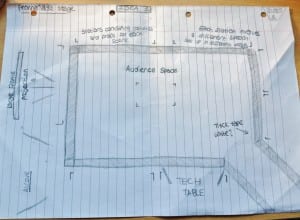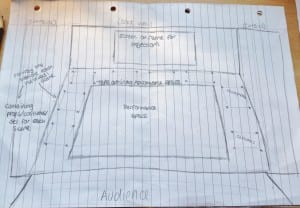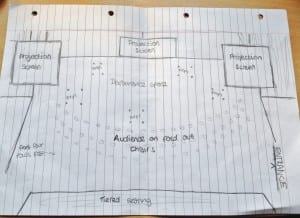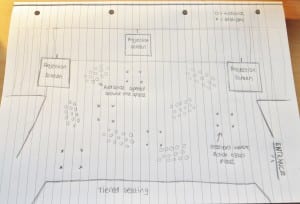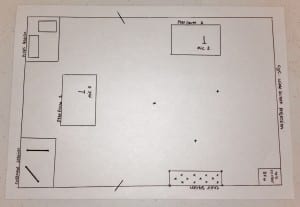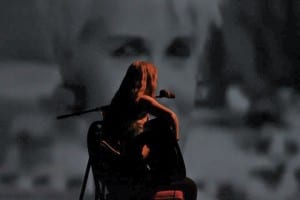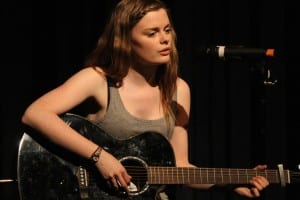The set and stage design is an important aspect for a theatre company to consider when producing a show, and the audience should be taken into consideration throughout this process: “The presence of an audience is central to the definition of theatre” (Freshwater 2009, p.1). The role that the audience holds within theatre has somewhat changed throughout recent decades and with the influence of more contemporary and avant-garde theatre. The bar has been raised, the boundaries have been broken and now the audience have more of a role to play in 21st century theatre. This change in paradigm can be seen within various aspects of theatre; one aspect that I shall focus on is the staging of a play. Within the work that Hand Me Down creates, being the set and stage designer, I believe that there need not be a strict boundary between the performer’s space and the audience space. In this way, the audience could be acknowledged or even used in some way within a performance. For our first production, Take Me By The Tongue, I have designed our staging in the style of promenade. This type of staging intends to very much involve the audience physically and include them as part of the set: “The proximity of the actors and the constant movement around the space combine to create an unusual and exciting event.” (Mackey and Cooper 2000, p.9). This performance is very fragmented, with various different scenes brought together with the aim to evoke different emotions and present different messages to our audience. Therefore promenade staging felt best suited as it is a fun and fresh way to perform this contemporary piece. In promenade performances, the audience will always “change their focus, move to watch the action or even interact or ‘mingle’ with the cast and action.” (Scottish Arts Council, 2010). Because of this, the genre of theatre we aim to create, along with our current project, works well in a promenade setting, with various different scenes in different areas of the stage giving a fragmented feel to the piece. This type of staging suits the company as well, and might be the staging we decide to use for other productions, depending on the length of future performances.
Helen Freshwater questions, “Do spectators simply watch?” (2009, p.2). It seems that theatre in the 21st century wants more involvement from their audiences, with audience interaction and acknowledgement becoming more popular amongst contemporary performance and art. Famously controversial contemporary artist Marina Abramovic pushes the audience role to the extreme and involves them within her performances, offering them the opportunity to actually change the outcome of a piece of her performance. Rhythm 0 (1974) and The Artist Is Present (2010) are just two of her performances that really push the relationship she has with her audience members to the limit, literally putting her life in their hands. Hand Me Down Theatre’s work aims to open a space for the audience to interlink with the performers, and in some cases will use eye contact and physical acknowledgement of their presence. However there is still a clear distinction between who the performer is and who the spectator is, and in this way our work is traditional and structured so as not to disrupt the narrative and the flow of a performance: “the relationship with the audience provides the theatre event with its rationale.” (Freshwater 2009, p.2).
There are many factors to research before designing the set and staging of a production. For example, if Hand Me Down were to tour to different venues, and we do carry on creating promenade performances, we would need to know the size of the space within the venues as to know whether, firstly, they are suitable for the set and equipment, and secondly, if the space is possible to be made into this style: “The director and designer establish aims and intentions. They will consider the more immediate concern of limitation and constraint imposed by space and budget.” (Thorne 1999, p.10). Having a small amount of set for Take Me By The Tongue, means that this production would be relatively easy to tour, along with the reasonable amount of props and costume. The role I have taken on in the company works closely with the production team and puts me very much in charge of the aesthetics of the shows we produce. When designing a show, good communication is vital between company members as some ideas may not be possible in terms of our budget and space, and therefore designs will change.
“A designer’s responsibilities cover all the visual elements of a production, including the acting space, props and lighting. The theatre designer is not entirely concerned with aesthetics for he must also be fully aware of the practicalities of that which he creates.” (Bond 2013, p.14).
Within the production team Andy, the production and stage manager, designs the lighting meaning my preliminary job is set and stage designer and designer of costume and props. Below are some designs from the early stages of the process, along with the lists of all costume and props used in Take Me By The Tongue.
Idea 1= Promenade staging (Auditorium flattened)
Idea 2= The traditional LPAC Auditorium staging
Idea 3= Auditorium flattened, chairs surrounding action
Idea 4= Auditorium flattened, audience in groups
Final design= Promenade staging (Auditorium flattened)
Punchdrunk is a very contemporary theatre company that produces “a form of theatre in which roaming audiences experience epic storytelling.” (Punchdrunk, 2014). Their performances take place in different locations, and their audiences are free to walk around the space and watch different sections of performance as they please. In this sense, their work is predominantly known as promenade theatre, and this has made them very successful. They enable their audience to experience what they choose, meaning their audience members may come away with a different experience to others. For example, their most recent production, The Drowned Man: A Hollywood Fable, takes place across four floors of a building in central London and lasts for three hours. The audience are therefore able to come and go as they wish and view different sections of the performance.
Below are a few photos of the staging for our first performance showing how we turned the LPAC auditorium into the promenade space we wanted for Take Me By The Tongue.
(Images taken by Libby Soper of the Lincoln Performing Arts Centre)
Work Cited:
Bond, Daniel (2013) Stage Management: A Gentle Art, London: Routledge.
Freshwater, Helen (2009) theatre & audience, London: Palgrave Macmillan.
Mackey, Sally and Simon Cooper (2000) Drama and Theatre Studies, London: Stanley Thornes.
Punchdrunk (2014) Punchdrunk Company – About. [online] Available at: http://punchdrunk.com/company/article/about [Accessed 28 April 2014].
Scottish Arts Council (2010) Arts in Scotland – Promenade. [online] Available at: http://www.scottisharts.org.uk/1/artsinscotland/drama/features/archive/themepromenade.aspx [Accessed 27 April 2014].
Thorne, Gary (1999) Stage Design: A Practical Guide, Wiltshire: The Crowood Press Ltd.

